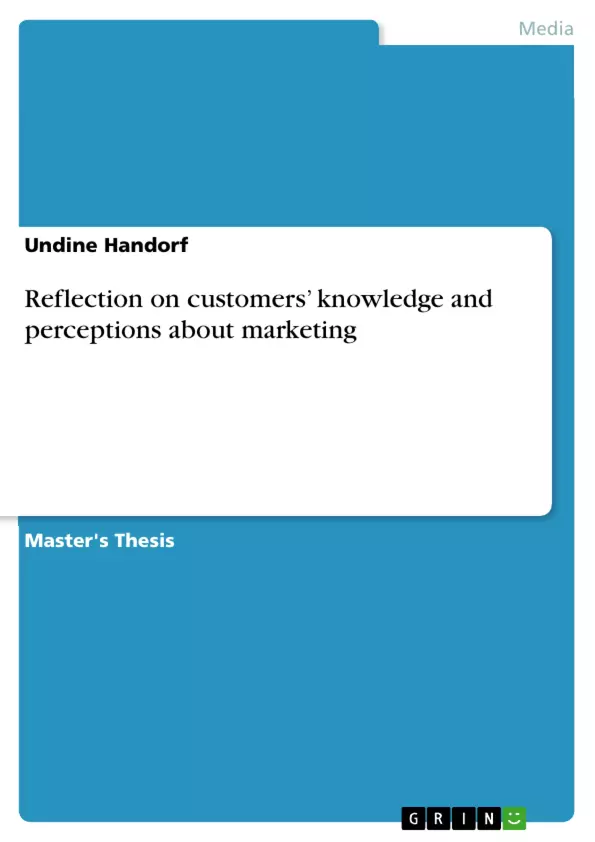This Master Thesis presents findings with regard to the stated discrepancy by means of a literature analysis and qualitative research in the form of focus groups. The research objective is to investigate customers’ and marketing professionals’ attitudes towards the discipline and how knowledge and/or experiences contribute to a positive or negative perception of marketing. The results suggest that customers are aware of the tactics used by marketers to deliberately mislead their target groups. Consequently, customers develop negative attitudes towards persuasive marketing efforts.
This thesis highlights the gap between laypersons’ negative perception and marketing academics’ added-value perception towards the discipline. In order to overcome this discrepancy, marketers need to consider customers’ scepticism as a compass and address positive impacts of marketing on customers and society.
Customers have gradually started emphasising on emerging marketing practices that seem to harm individuals, societies and the environment. However, marketing scholars believe that marketing has positive impacts and creates values and satisfaction for all stakeholders.
Table of Contents
- 1 Introduction
- 1.1 Background Situation and Research Problem
- 1.2 Research Objectives and Research Questions
- 1.3 Scope and Limitations
- 1.4 Research Methodology and Justification
- 1.5 Structure of the Thesis
- 2 Theoretical Exploration of current Perceptions of Marketing
- 2.1 Perception and Knowledge in Research
- 2.1.1 Perception and Knowledge
- 2.1.2 Persuasion Knowledge Model
- 2.2 Public Criticism about Marketing
- 2.2.1 Scepticism towards Advertising
- 2.2.2 Manipulative Marketing Practices
- 2.2.3 Deceptive Pricing Policies
- 2.2.4 Consumption-Oriented Lifestyles
- 2.2.5 Scepticism towards Green Advertising
- 2.3 Marketers' Responses to Public Scepticism
- 2.3.1 Academic Understanding of Marketing
- 2.3.2 Demarketing and Mindful Consumption
- 2.3.3 Reforming Pricing Strategies
- 2.3.4 Sustainable Marketing Practices
- 3 Empirical Research
- 3.1 Research Objectives
- 3.2 Research Methodology
- 3.2.1 Focus Group Composition
- 3.2.1.1 Sampling Technique
- 3.2.1.2 Recruiting of Participants
- 3.2.2 Data Collection
- 3.2.2.1 Interview Guideline
- 3.2.2.2 Focus Group Execution
- 4 Analysis and Interpretation of Collected Data
- 4.1 Data Analysis Method
- 4.2 Presentation and Interpretation of Findings
- 4.2.1 General attitudes towards Marketing
- 4.2.1.1 Advantages and positive perceptions
- 4.2.1.2 Resentments and negative perceptions
- 4.2.1.3 Functional versus social understanding of Marketing
- 4.2.2 Marketing as Manipulation
- 4.2.2.1 Dimensions of Manipulation
- 4.2.2.2 Objectives of Manipulation
- 4.2.2.3 Receptive target groups
- 4.2.3 Consumption-oriented life-styles
- 4.2.3.1 Meaning of Consumption
- 4.2.3.2 Marketing as driver of Consumption
- 4.2.3.3 Consequences of over-consumption
- 4.2.4 Pricing Policies
- 4.2.4.1 Social versus personal (un)fairness
- 4.2.4.2 Pricing strategies and objectives
- 4.2.5 Sustainability and Greenwashing
- 4.2.5.1 Purchasing motives
- 4.2.5.2 Marketing and Sustainability
- 4.2.5.3 Marketing and Greenwashing
- 5 Final Discussion
- 5.1 Summary
- 5.2 Limitations
- 5.3 Implications and Recommendations
- 5.4 Future Research
Objectives and Key Themes
This Master Thesis aims to investigate the discrepancy between customers' negative perception of marketing and marketing professionals' belief in its positive impacts. The study explores customers' knowledge and perceptions of marketing practices through a literature analysis and qualitative focus group research. The research seeks to understand how customers' knowledge and experiences shape their attitudes towards marketing and to identify the underlying reasons for their scepticism.
- The relationship between customers' knowledge and perceptions of marketing
- The impact of marketing practices on customer attitudes
- The gap between academic understanding of marketing and public criticism
- The role of persuasion knowledge in shaping customer attitudes
- The importance of addressing customer scepticism in marketing practices
Chapter Summaries
The first chapter introduces the background situation and research problem, outlining the discrepancy between customers' negative perceptions of marketing and marketing academics' positive view of the discipline. The research objectives and questions are formulated, and the scope and limitations of the study are defined. The research methodology, based on a literature analysis and qualitative focus group research, is justified. The thesis structure is then presented.
Chapter two provides a theoretical exploration of current perceptions of marketing, covering various aspects of perception and knowledge in research, including the Persuasion Knowledge Model. The chapter further examines public criticism of marketing, focusing on scepticism towards advertising, manipulative marketing practices, deceptive pricing policies, consumption-oriented lifestyles, and scepticism towards green advertising. Finally, it discusses marketers' responses to public scepticism, highlighting academic understandings of marketing, demarketing and mindful consumption, reforming pricing strategies, and sustainable marketing practices.
Chapter three focuses on the empirical research conducted in this thesis. It outlines the research objectives and methodology, detailing the focus group composition, sampling technique, recruiting of participants, data collection methods, and the execution of the focus groups.
Chapter four presents an analysis and interpretation of the collected data. The chapter describes the data analysis method and provides detailed insights into the findings, covering general attitudes towards marketing, including advantages, resentments, and the functional versus social understanding of marketing. It delves into the perception of marketing as manipulation, exploring its dimensions, objectives, and receptive target groups. The chapter further analyzes consumption-oriented lifestyles, examining the meaning of consumption, marketing as a driver of consumption, and the consequences of over-consumption. It concludes by investigating pricing policies, specifically social versus personal fairness and pricing strategies, and delves into sustainability and greenwashing, exploring purchasing motives, the relationship between marketing and sustainability, and the issue of greenwashing.
Keywords
The thesis focuses on the critical examination of marketing, examining customer attitudes towards the discipline and the gap between public perception and academic understanding. The research explores the impact of persuasive marketing tactics on customer scepticism and the need for marketers to address these concerns by considering positive impacts on both customers and society. Keywords include: Marketing criticism, customer attitudes, positive marketing, persuasion knowledge, deceptive marketing practices, sustainable marketing, and consumer behaviour.
- Quote paper
- M.A. Undine Handorf (Author), 2016, Reflection on customers’ knowledge and perceptions about marketing, Munich, GRIN Verlag, https://www.grin.com/document/383158



